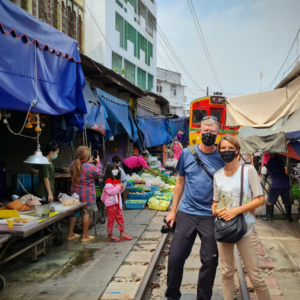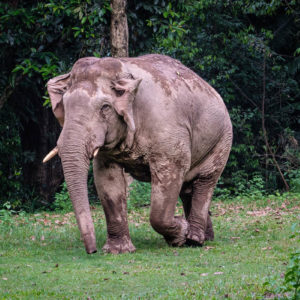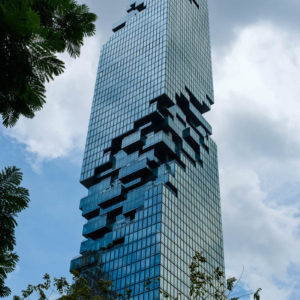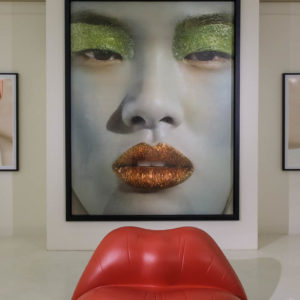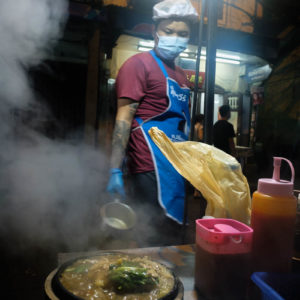An extended stay in Thailand is a great opportunity to learn how to cook some Thai dishes, so we booked a private cooking class for Wednesday morning. The cooking school was in a completely different part of town, and it was fun to walk through a very different neighborhood from our ‘home’. Teacher Pim was a cheerful lady who quickly taught us how to make Tom Yum Goong (sweet and sour soup with shrimp), Pad Thai (with tamarind paste), the inevitable mango sticky rice and at our request: spring rolls with chili sauce! The biggest eye opener of the morning for me, was the use of tapioca flour. You thicken sauces with it, but you can also use it to make straight up glue! With that glue, and our fingers, we glued our spring rolls together before throwing them into the frying pan. Such fun! A second, important takeaway was that none of the dishes are very complicated to make, but finding the right ingredients in the Netherlands will become a challenge. Anyway, if you’re reading this, we’d like to invite you to come and taste some of our food when we’re back!
I had already decided that Erwin’s birthday in February was a good excuse to score some Michelin stars again, so two days later we went to visit R-Haan. We ate some 20 beautiful small bites, certainly worth a few stars in appearance and sophistication, and very Thai in terms of ingredients and taste profile. An amazing experience! I was curious what we would drink with the meal because wine is not necessarily typically Thai, but they offered the usual wine pairings. We didn’t think all of them were spot on, but the red wine with one of the main courses held up great with the chili in the dish, and I thought that was very well done. After eating so many goodies we couldn’t finish the petit fours with the coffee, but we were allowed to take them out in a beautiful little box.
Earlier in the day, we visited one of the most famous floating markets in Thailand, the Damnoen Saduak market, on a guided tour. The market is located about 2 hours outside of the city and it’s the only floating market that is open on weekdays as well as weekends. The market clearly showed the damage COVID-19 has caused to tourism. 75% of the shops in the market were closed, and there were hardly any visitors and even fewer sellers on the water. You could clearly see what a tourist trap it normally must be, but now the atmosphere was very different. Not that we had a huge problem with that: at least now we did not have to breathe in the exhaust fumes of a ton of long tail boats, which apparently is an issue in normal times.
The second part of our day trip was a visit to the famous Maeklong train market. Because some market traders found the rents of the stalls in the normal covered market too high, they set up their stalls just outside the market hall, along the track. At the time, that cost nothing. People are now paying for those places, but still much less than they would pay for a stand in the market hall. Because the stalls are so close to the track, they have to be pushed aside every time a train arrives. Before COVID-19 that happened about 8 times a day, now only 4 times. We got there in time to watch this shuffle, and that was pretty amusing. The tables that the market vendors use have wheels, so you can move them easily enough, but you are still talking about two times a few hundred meters of the market that has to move a meter backwards. Our guide was certainly not doing this trip for the first time, because we were given specific instructions: as soon as the train had passed, we had to get on the track, so he could take a picture of us with the train in the background. And so it happened…
We used the weekend to visit Khao Yai, Thailand’s oldest national park, which is a few hours north-east of Bangkok. We had again arranged a guide for the park, but we had to make our own way to Pak Chong, the city closest to the park. There is a direct train from Bangkok that takes three hours, so that seemed like a nice trip.The Bang Sue Grand Station in Bangkok is a colossal, new, shiny, air-conditioned building. When our taxi driver dropped us off there it was very busy, with lines of people in front of different doors and many staff checking papers. We thought it a bit unusual that we had to show our vaccination papers (they did not even ask for those before our flight to Bangkok), and even more strange that once inside we had to fill out a health declaration to be allowed on the train. Until we came across the ‘I hereby consent to be vaccinated’ checkbox… this part of the station was used as a vaccination center!
A center at that, where none of the staff spoke a word of English, so no one understood us when we tried to explain that we’ve already had three shots and that all we wanted to do was take the train… It took another visitor to translate for us, but then one of the vaccination staff was willing to take us to the right place. He dragged us all over the building at great speed, to various information and ticket counters (despite our protests that we already had a ticket), but we couldn’t find the platform to Pak Chong anywhere. Until we finally found out that our train didn’t leave from this station but from the little rickety station across the street, where you could just walk over the track to cross it and where you had to wait outside for the train. More evidence of the positive effect of Covid vaccinations: without the help of vaccine boy, we probably would not have found the right departure platform.
Fortunately, there were more helpful people around. Because although we were now waiting at the right station, it turned out we were not yet at the right platform. Which we found out when the train was already arriving and someone from the staff warned everyone else waiting to cross the track and go to the next platform. So we crossed the tracks. Or I did, at least. Because just when Erwin wanted to cross the track as well, a loooooooooooooong train arrived from the other side, making crossing far too dangerous. So there I was, alone on the right platform, separated from my lover by a large train, with our train about to leave. I didn’t want to go alone! Finally, the new train came to a stop and someone helped Erwin and a few other Pak Chong travelers to reach the correct platform through the train, and we were able to hit the road – or rather rails – together again. Phew.
The next day, our guide Lek picked us up from our hotel to go to Khao Yai. It’s a very large park, with only a few roads, so the wildlife has plenty of living space there. We were lucky and almost immediately saw a number of hornbills, including the largest species, the giant hornbill. That is one of the animals the park is known for. Later we also saw an elephant, lots of monkeys, macaques and white and black gibbons, samba and barking deer, and during the evening safari we even saw a huge python!
Somehow I had understood from the tour operator website that we would receive special socks against ticks during the trip. And we did get those: a kind of cotton spats that you had to put on over your socks before you got into your shoes, and that you could fasten with a string around your calves. Of course it was very uncomfortable, that extra layer of crumpled fabric in your shoes, and besides, there were no signs of any ticks for the first few hours, so I got the urge to take them off.
Until… we found the first leeches on our stockings. And our legs. And on the edge of our shoes just before they crawled in. Do you know what a leech looks like? No? Keep it like that! They are rotten little worms that hide under the damp leaves and can swing onto your shoes in a split second. The first day there were ‘only’ a few that jumped us, but the second day, when we were only a few minutes into our new walk, you could see them crawling on the ground. In no time I had about ten of those suckers on my legs and IN MY SHOES! Our guide was a hero because he plucked all the leeches off me with his fingers. After that we decide to take another trail, less exciting but paved and therefore without leeches.Fun fact: leeches are normally not active in the park ‘in winter’ – the dry season. But the 2022 dry season is unusually wet, so the critters had sprung to life a few months earlier than usual. Just our luck. Another fun fact: you don’t feel a leech bite, but they do cause blood stains on your clothes and a dark spot on your skin that only disappears after a few days. And a final one: apparently, if you’re in an area with leeches, it’s safer to tuck your shirt into your pants than to walk around in a baggy t-shirt. How I know that? The ‘tick socks’ worked fine, but I got a leech bite on my stomach on the second day.
Anyway. I just looked at the tour operator’s site and indeed, they offer free ‘leech protection socks’. I had in my head that they were drawing socks! If I had read and translated that correctly when I booked, we would have skipped a beautiful national park.
We ended our trip in Khao Yai a little earlier than planned, due to a tropical downpour. Fortunately, the taxi was able to pick us up earlier and so we were back in Bangkok on Monday evening. Of course we stayed at a different hotel this time, in a slightly different neighbourhood, Silom. We always like visiting new places more than going to the same place twice, but there was another reason for the move. Our old hotel was close to ‘Soi Cowboy’, a famous nightlife street of dubious quality. There are dozens of ‘massage parlors’ in the surrounding streets, for which the masseuses try to recruit customers on the sidewalk. When Erwin and I walked past them together to go to the hotel, they did so with little enthusiasm, but when Erwin walked by alone he was sometimes literally jumped by the ladies. When I heard that, I just let Erwin leave the house without a credit card and with only a few Baht in pocket money, but that was hardly a permanent solution, of course.Silom is a centrally located neighbourhood with many offices, shopping centers, high-rise buildings, crowds and good public transport. A great place to work for a few more days and see some sights every now and then. Such as the famous Wat Pho (where Erwin went alone when I was working), the royal palace, the MOCA (museum of contemporary art) and the Mahanakhon skywalk – that’s the 74th floor of this original building, that offers a great view of the city. The space outside was closed due to maintenance, but by way of compensation we got a ‘show’ from the window cleaners who stepped over the railing to sit on a plank and wash the facades with a bucket and a squeegee in their hand. Very scary, and all I had to do was look!
On our last evening in Bangkok, Friday 25 March, we went out again with a guide, this time in Chinatown, to try all kinds of street food. We had been to Chinatown a week and a half earlier on Monday evening and we thought it was quite boring there. Turns out, that’s because Monday evening is the one night that all street food vendors are free and all restaurants are closed. Now it was pleasantly busy, and we were able to fill our bellies with lots of interesting & good dishes. Like for instance the green curry from a tiny roadside restaurant that features in the Netflix documentary about ‘Asian street food’. And a dessert made from bird’s nests. In between, we had noodles at a couple of different places. And then some more desserts. All very tasty, but altogether, we ate a lot!
By now, we have decided to take advantage of the fact that from April 1, fully vaccinated people are no longer required to quarantine upon entering South Korea. That means we only have a few days left in Thailand before we go back to the relative cold. So we’re going to spend this time on the beach and by the pool! We’re in Hua Hin, a seaside resort a few hours south of Bangkok. It’s located on the other side of the Thai Gulf from Pattaya and it’s smaller, quieter, and a bit more upmarket than that. While last weekend was still quite busy with Thai families from Bangkok, there are now mainly elderly white people left in the town. And us. Including us? Hmm… well, anyway: ‘Us’ are having a great time here!
